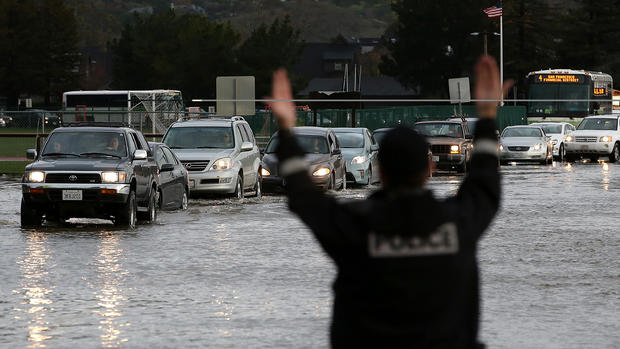40 people rescued from flash flood in California
LOS ANGELES -- A dayslong storm took a parting shot as it moved out of the drought-stricken state Thursday, dumping more heavy rain that triggered a flash flood and stranded more than three dozen people in their cars in Southern California.
Five vehicles got stuck shortly after 1 a.m. as several feet of mud and water roared over a rural road near Gilman Hot Springs about 80 miles southeast of Los Angeles, Riverside County fire officials said.
A woman in one car was "hanging out of the passenger side of her vehicle screaming for help," California Highway Patrol Sgt. Adrian Horta said.
Horta said he was able to steer his SUV alongside the car and pull the woman and her male companion out through a window on the road north of Hemet, a valley city surrounded by hills and mountains.
"The mountain slide had come down and it was about 4 feet deep," he told KCBS-TV.
A swift water rescue crew rescued 12 other motorists. Over the next several hours, rescuers pulled 26 more people from cars in the Hemet and San Jacinto areas, county fire spokesman Lucas Spelman said. Several cars and SUVs remained stuck in mud, some with only their roofs exposed.
Residents of eight nearby homes were evacuated as a precaution, and numerous roads in the inland region were closed, Spelman said.
South in San Diego County, morning floodwaters sent a mudflow 80 feet wide into roads in the Alpine area.
The diminishing Pacific system brought three days of rain to California. There was some flooding and evacuations near hillsides stripped bare by wildfires, but the Los Angeles area avoided major damage despite some huge rainfall totals. An exceptional 14.5 inches has fallen since Tuesday at Yucaipa Ridge in the San Bernardino Mountains, the National Weather Service said.
Most other parts of the state received 2 to 4 inches of rain.
The storm dropped snow in mountains key to the state's water supply and made signature waterfalls flow at Yosemite National Park, including the 2,425-foot Yosemite Falls that had slowed to a trickle in mid-July.
But the needed soaking also caused problems: likely opening a pair of sinkholes in San Francisco, including a 20-by-30-foot chasm in a neighborhood, and flooding freeways in Sacramento, tangling the Wednesday rush-hour commute.
The San Francisco Bay Area reached or exceeded normal annual rainfall totals for the first time in years.
Just before the storm arrived, the Sierra Nevada snowpack - which accounts for most of the state's water supply - was at just 24 percent of normal for this time of year. But snow was building rapidly with reports of 10 inches of snowfall at elevations of 8,000 feet.
That good news was tempered by a stark reality: California needs many more such storms to alleviate a three-year drought.
CBS Los Angeles reports that crews have been working around the clock to keep drainage canals and basins clear amid the storm that brought record rainfall to the Southland.
Stan Brown, a public works supervisor, said he's been keeping a close eye on one of six basins above Glendora designed to trap mud flows and debris but also serves to capture water to recharge the local groundwater supply.
"That's very important to us particularly in this drought sort of situation that we're in right now. The current figure that we have is, as of today, as a result of this storm alone, we've been able to capture about 1.34 billion gallons of water and that's probably enough for about 30,000 residents for a year," said Bob Spencer of the Los Angeles County Department of Public Works.
